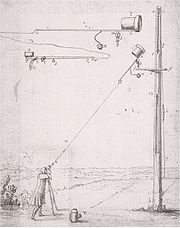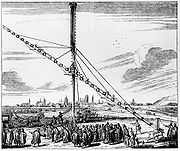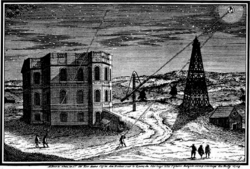
Aerial telescope
Encyclopedia

Refracting telescope
A refracting or refractor telescope is a type of optical telescope that uses a lens as its objective to form an image . The refracting telescope design was originally used in spy glasses and astronomical telescopes but is also used for long focus camera lenses...
built in the second half of the 17th century that did not use a tube. Instead, the objective
Objective (optics)
In an optical instrument, the objective is the optical element that gathers light from the object being observed and focuses the light rays to produce a real image. Objectives can be single lenses or mirrors, or combinations of several optical elements. They are used in microscopes, telescopes,...
was mounted on a pole, tree, tower, building or other structure on a swivel ball-joint. The observer stood on the ground and held the eyepiece
Eyepiece
An eyepiece, or ocular lens, is a type of lens that is attached to a variety of optical devices such as telescopes and microscopes. It is so named because it is usually the lens that is closest to the eye when someone looks through the device. The objective lens or mirror collects light and brings...
, which was connected to the objective by a string or connecting rod. By holding the string tight and maneuvering the eyepiece, the observer could aim the telescope at objects in the sky. The idea for this type of telescope may have originated in the late 17th century with the Dutch
Netherlands
The Netherlands is a constituent country of the Kingdom of the Netherlands, located mainly in North-West Europe and with several islands in the Caribbean. Mainland Netherlands borders the North Sea to the north and west, Belgium to the south, and Germany to the east, and shares maritime borders...
mathematician
Mathematics
Mathematics is the study of quantity, space, structure, and change. Mathematicians seek out patterns and formulate new conjectures. Mathematicians resolve the truth or falsity of conjectures by mathematical proofs, which are arguments sufficient to convince other mathematicians of their validity...
, astronomer
Astronomer
An astronomer is a scientist who studies celestial bodies such as planets, stars and galaxies.Historically, astronomy was more concerned with the classification and description of phenomena in the sky, while astrophysics attempted to explain these phenomena and the differences between them using...
and physicist
Physics
Physics is a natural science that involves the study of matter and its motion through spacetime, along with related concepts such as energy and force. More broadly, it is the general analysis of nature, conducted in order to understand how the universe behaves.Physics is one of the oldest academic...
Christiaan Huygens and his brother Constantijn Huygens, Jr.
Constantijn Huygens, Jr.
Constantijn Huygens Jr. was a Dutch statesman also known for his work on scientific instruments and as a chronicler of his times...
, though it is not clear that they invented it.
Invention and application

Very long "tubed" telescopes
Telescopes built in the 17th and early 18th century used single element non-achromatic objectiveNon-achromatic objective
A non-achromatic objective is an objective lens which is not corrected for chromatic aberration. In telescopes they can a be pre-18th century simple single element objective lenses which were used before the invention of doublet achromatic lenses...
lenses that suffered from interfering rainbow halos
Halo (optical phenomenon)
A halo from Greek ἅλως; also known as a nimbus, icebow or gloriole) is an optical phenomenon produced by ice crystals creating colored or white arcs and spots in the sky. Many are near the sun or moon but others are elsewhere and even in the opposite part of the sky...
(chromatic aberration
Chromatic aberration
In optics, chromatic aberration is a type of distortion in which there is a failure of a lens to focus all colors to the same convergence point. It occurs because lenses have a different refractive index for different wavelengths of light...
) introduced by the non-uniform refractive properties of single glass lenses. This degraded the quality of the images they produced. Telescope makers from that era found that a very long focal length objectives had no appreciable chromatic aberration (the uncorrected chromatic aberration fell within the large diffraction
Diffraction
Diffraction refers to various phenomena which occur when a wave encounters an obstacle. Italian scientist Francesco Maria Grimaldi coined the word "diffraction" and was the first to record accurate observations of the phenomenon in 1665...
pattern at focus). They also realized that when they doubled the diameter of their objectives they had to make the objective's focal length 4 times as long (focal length had to be squared) to achieve the same amount of minimal chromatic aberration. As the objective diameter of these refracting telescopes was increased to gather more light and resolve finer detail they began to have focal lengths as long as 150 feet. Besides having really long tubes these telescopes needed scaffolding or long masts and cranes to hold them up. Their value as research tools was minimal since the telescope's support frame and tube flexed and vibrated in the slightest breeze and sometimes collapsed altogether.
Tubeless "aerial" telescopes
Around 1675 the brothers Christiaan and Constantine Huygens decided to accommodate the very long focal length objectives they were creating by eliminating the tube altogether. In Huygens "aerial" telescope the objective was mounted inside a short iron tube mounted on a swiveling ball-joint on top of an adjustable mast. The eyepiece was mounted in another short tube (sometimes on a stand) and the two tubes were kept aligned by a taut connecting string. Christiaan Huygens published designs for these tubeless "Aerial telescopes" in his 1684 book "Astroscopia Compendiaria" and their invention has been attributed to him and his brother Constantijn, although similar designs were being used by Adrien AuzoutAdrien Auzout
Adrien Auzout was a French astronomer.He was born in Rouen, France, the son of a clerk in the court of Rouen. His educational background is unknown. In 1664–1665 he made observations of comets, and argued in favor of their following elliptical or parabolic orbits...
and the idea is even sometimes attributed to Christopher Wren
Christopher Wren
Sir Christopher Wren FRS is one of the most highly acclaimed English architects in history.He used to be accorded responsibility for rebuilding 51 churches in the City of London after the Great Fire in 1666, including his masterpiece, St. Paul's Cathedral, on Ludgate Hill, completed in 1710...
.
The Huygens contrived some ingenious arrangements for aiming these "aerial telescopes" at an object visible in the night sky. The telescope could be aimed at bright objects such as planets by looking for their image cast on a white pasteboard ring or oiled translucent paper screen and then centering them in the eyepiece. Fainter objects could be found by looking for the reflection of a lamp held in the observers hand being bounced back by the objective and then centering that reflection on the object. Other contrivances for the same purpose are described by Philippe de la Hire
Philippe de La Hire
Philippe de La Hire was a French mathematician and astronomer. According to Bernard le Bovier de Fontenelle he was an "academy unto himself"....
and by Nicolaas Hartsoeker. The objectives for aerial telescopes could have very long focal lengths. Christiaan Huygens states that in 1686 he and his brother made objectives of 8 inch (200mm) and 8.5 inch (220mm) diameter and 170 and 210 ft (52 and 64 m) focal length respectively. Constantijn Huygens, Jr. presented a 7.5 inch (190mm) diameter 123 ft (37.5 m) focal length objective to the Royal Society of London in 1690. Adrien Auzout and others made telescopes of from 300 to 600 ft (90 to 180 m) focal length and Auzout proposed a huge aerial telescope 1,000 feet in length that he would use to observe animals on the Moon.
Applications

Giovanni Domenico Cassini
This article is about the Italian-born astronomer. For his French-born great-grandson, see Jean-Dominique Cassini.Giovanni Domenico Cassini was an Italian/French mathematician, astronomer, engineer, and astrologer...
had the wooden Marly Tower, originally built as part of the Machine de Marly
Machine de Marly
The Machine de Marly, also widely known as La Machine de Marly and The Machine of Marly, was a French engineering marvel completed in 1684. King Louis XIV needed a large water supply for his fountains at Versailles...
to lift water for the reservoirs and fountains at the Gardens of Versailles
Gardens of Versailles
The Gardens of Versailles occupy part of what was once the Domaine royal de Versailles, the royal demesne of the château of Versailles. Situated to the west of the palace, the gardens cover some 800 hectares of land, much of which is landscaped in the classic French Garden style perfected here by...
, moved to the grounds of the Paris Observatory
Paris Observatory
The Paris Observatory is the foremost astronomical observatory of France, and one of the largest astronomical centres in the world...
. On this tower he mounted long tubed telescopes and the objectives of aerial telescopes made for him by the Italian optician Giuseppe Campani
Giuseppe Campani
Giuseppe Campani was an Italian optician and astronomer who lived in Rome during the latter half of the 17th century.His brother, Matteo Campani-Alimenis, and he were experts in grinding and polishing lenses, especially for very long focal length aerial telescope objectives...
. In 1684 he used one of his aerial telescopes to find Dione
Dione (moon)
Dione is a moon of Saturn discovered by Cassini in 1684. It is named after the titan Dione of Greek mythology. It is also designated Saturn IV.- Name :...
and Tethys
Tethys (moon)
Tethys or Saturn III is a mid-sized moon of Saturn about across. It was discovered by G. D. Cassini in 1684 and is named after titan Tethys of Greek mythology. Tethys is pronounced |Odysseus]] is about 400 km in diameter, while the largest graben—Ithaca Chasma is about 100 km wide and...
, two satellites of Saturn
Saturn
Saturn is the sixth planet from the Sun and the second largest planet in the Solar System, after Jupiter. Saturn is named after the Roman god Saturn, equated to the Greek Cronus , the Babylonian Ninurta and the Hindu Shani. Saturn's astronomical symbol represents the Roman god's sickle.Saturn,...
. James Bradley
James Bradley
James Bradley FRS was an English astronomer and served as Astronomer Royal from 1742, succeeding Edmund Halley. He is best known for two fundamental discoveries in astronomy, the aberration of light , and the nutation of the Earth's axis...
, on December 27, 1722, measured the diameter of Venus
Venus
Venus is the second planet from the Sun, orbiting it every 224.7 Earth days. The planet is named after Venus, the Roman goddess of love and beauty. After the Moon, it is the brightest natural object in the night sky, reaching an apparent magnitude of −4.6, bright enough to cast shadows...
with an aerial telescope whose objective had a focal length of 212 ft (65 m). Francesco Bianchini
Francesco Bianchini
Francesco Bianchini was an Italian philosopher and scientist. He worked for the curia of three popes, including being camiere d`honore of Clement XI, and secretary of the commission for the reform of the calendar, working on the method to calculate the astronomically correct date for Easter in a...
tried to map the surface of that same planet and deduce its rotational period in Rome in 1726 using a 2.6" (66mm) 100 foot focal length aerial telescope.
Obsolescence
The extreme difficulty of using these very long focal length telescopes led astronomers to develop alternative designs. One was the reflecting telescopeReflecting telescope
A reflecting telescope is an optical telescope which uses a single or combination of curved mirrors that reflect light and form an image. The reflecting telescope was invented in the 17th century as an alternative to the refracting telescope which, at that time, was a design that suffered from...
. In 1721 John Hadley
John Hadley
John Hadley was an English mathematician, inventor of the octant, a precursor to the sextant, around 1730.He was born in Bloomsbury, London, to Katherine FitzJames and George Hadley....
showed a Newtonian reflecting telescope
Newtonian telescope
The Newtonian telescope is a type of reflecting telescope invented by the British scientist Sir Isaac Newton , using a concave primary mirror and a flat diagonal secondary mirror. Newton’s first reflecting telescope was completed in 1668 and is the earliest known functional reflecting telescope...
to the British Royal Society
Royal Society
The Royal Society of London for Improving Natural Knowledge, known simply as the Royal Society, is a learned society for science, and is possibly the oldest such society in existence. Founded in November 1660, it was granted a Royal Charter by King Charles II as the "Royal Society of London"...
with 6 inch in diameter mirror that compared favorably with Huygens large aerial telescope. The need for very long focal length telescope objectives was eliminated with the invention of the achromatic lens
Achromatic lens
An achromatic lens or achromat is a lens that is designed to limit the effects of chromatic and spherical aberration. Achromatic lenses are corrected to bring two wavelengths into focus in the same plane....
in the middle of the 18th century.
See also
- History of the telescope
- List of telescope types
- Infinite-axis telescopeInfinite-axis telescopeAn infinite-axis telescope is a telescope that can move freely in all directions. Such telescopes can be mechanically simple hand-guided versions with the mounting serving only to carry the weight of the telescope although there are equatorial versions....
External links
- Huygens and His Great Refractor
- Institute and Museum of the History of Science - Galileo's telescope - Chromatic aberration, animation explaining the need for very long focal length lenses due to Chromatic aberration.
- ESA - Proceedings of the International Conference - "Titan, from discovery to Encounter". Extensive detail on Cassini, Huygens and Optics, and Campani's lenses.

